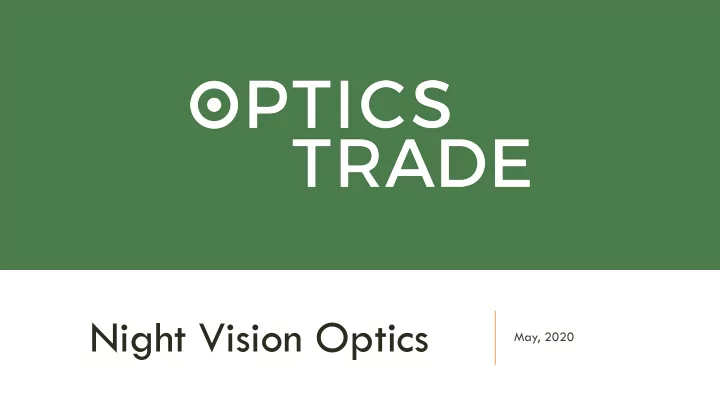

Night Vision Optics May, 2020
NIGHT VISION OPTICS • The first devices were developed in 1935, called Gen. 0 NV devices • The first passive analog NV devices which could operate with the ambient light were called Gen. 1 NV, which are still available today • Later the Gen. 2 NV devices were developed, which made the biggest step in the night vision history between two generations • The most advanced NV devices currently on the market are Gen. 3 devices • The latest development in NV are digital NV devices
GENERAL FEATURES • Night vision devices are devided into analog and digital devices • Analog NV devices amplify the light in the darkness with the help of an IIT • Analog devices are classified by generations, which tells us how much the image intensifier tube amplifies the light • The image seen through analog NV devices is direct, with no screen in between like in digital devices • Digital NV devices have a sensor behind the objective lens, which captures the image • The image gets converted into electrical signals, which are then displayed on the screen in the ocular • Digital and analog night vision devices are available in many different shapes and sizes, each designed for a different purpose: • Night vision binoculars • Night vision monoculars (scopes) • Night vision goggles • Night vision clip-on devices
ANALOG AND DIGITAL NIGHT VISION OPTICS • Analog night vision devices are classified by generations, and these are available on the market: • Generation 1 Night vision devices • Generation 1+ Night vision devices • Generation 2 Night vision devices • Generation 2+ Night vision devices • Generation 3 Night vision devices • The image color is normally black and green, but from the 2 nd generation upwards, also better IITs are available, which display a black and white picture. • Digital night vision devices are the latest development for nighttime observations • Digital NV devices have a sensor behind the objective lens, which captures the image • The image gets converted into electrical signals, which are then displayed on the screen in the ocular • All digital night vision devices have a refresh rate
Pros and cons of analog night vision devices • (+) Generation 2 and 3 analog night vision devices have very good contrast and light amplification • (+) The image looks real and not like as you would look into a screen • (+) Generation 3 rarely need an additional IR illuminator • (+) Generation 2 devices need an IR illuminator only in complete darkness • (+) Are not sensitive to reflections • (+) For longer time observations analog devices are a lot more comfortable to use • (+) Very low battery consumption • (-) High price • (-) Gen. 1 devices are affordable, but the image quality is not so good • (-) They don ´ t feature some special features like taking photos or videos • (-) are very sensitive to bright light sources (can be damaged during the day)
Pros and cons of digital night vision devices • (+) Are a lot cheaper than Gen. 2 and Gen 3 NV devices • (+) With the combination of a high-quality IR illuminator, the digital NV device can be very useful also on greater distances • (+) In most cases, they perform even better than generation 1 night vision devices. • (+) Compared to Gen. 1 night vision devices, the digital ones have the advantage that IR illuminators with long wavelengths can be used, which are completely invisible to all animals • (+) They feature digital magnification • (+) Possible to make photos and videos • (+) Connectivity to a smartphone, tablet and computer • (+) Can be used during the day • (-) Very bright picture even on the lowest settings • (-) Reflecting objects disturb the image • (-) Big battery consumption
INFRARED ILLUMINATORS • The human eye can see light in wavelengths from 380 to 740 nanometers. This wavelength spectrum is also called the visible light • Wavelengths that are beyond the visible spectrum are longer and are called infrared wavelengths or infrared light General features • An IR illuminator is a flashlight that emits light in an infrared spectrum • IR illuminators are available in different wavelengths • The wavelength tells us, in combination with what kind of night vision they are designed to be used For example: • Most analog night vision devices on the market with a Gen. 1 IIT can see wavelengths up to 760-780nm. • The most Gen. 2 NV devices can detect the light of wavelengths up to 850nm. Some special IIT ´ s from Photonis, like Photonis ECHO or XR-5, can detect light even up to 900nm. • Gen. 3 NV devices can detect wavelengths up to 900nm, and the best Gen. 3 IIT ´ s, like Photonis 4G, 4G+, and XR5, can detect wavelengths even up to 1000nm. Digital NV devices can detect wavelengths up to 950nm – 980nm
IR illuminators for analog night vision devices • For analog night vision devices, only specific infrared illuminators work perfectly • The buyer has to be cautious what is the maximal wavelength the NV can detect We recommend the following: • For Gen. 1 NV devices an IR illuminator with a wavelength between 750nm and 780nm, • For Gen. 2 devices an illuminator with a wavelength of 850nm, or up to 900nm illuminator if a high-quality IIT is built into the device • For Gen. 3 devices an IR illuminator is mostly not needed, but an illuminator with a wavelength of 850nm - 900nm would work perfectly with all image intensifier tubes IR illuminators for digital night vision devices • Digital night vision devices are not very picky – they detect all wavelengths up to 950nm-980nm • Because animals can detect wavelengths up to 850nm, we recommend an IR illuminator with a wavelength over 850nm.
Recommend
More recommend